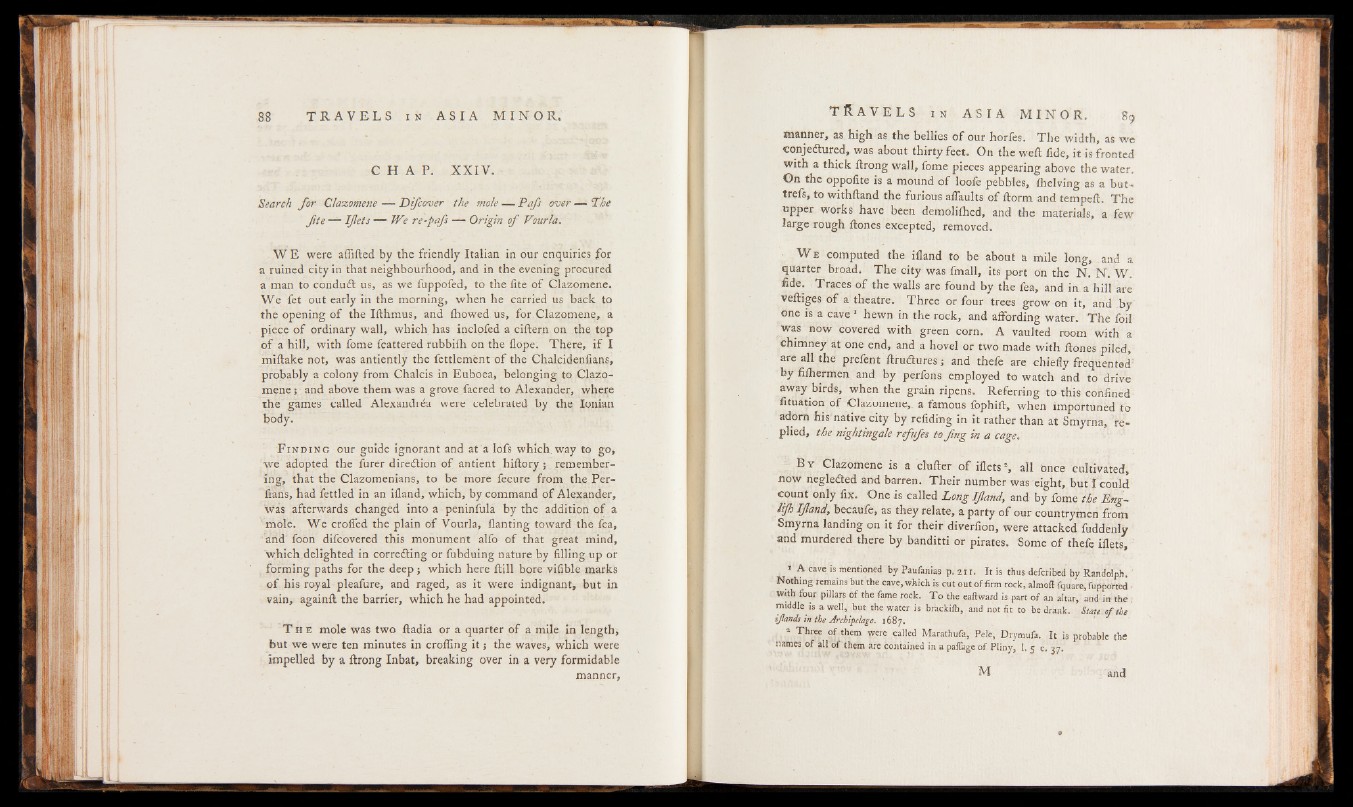
C H A P . X X IV .
Search fo r Clazomene — Difcover the mole — Pafs over — The
fite — IJlets — We re-pafs — Origin o f Vourla.
W E were afiified by the friendly Italian in our enquiries for
a ruined city in that neighbourhood, and in the evening procured
a man to condudt us, as we fuppofed, to the fite of Clazomene.
We fet out early in the morning, when he carried us back to
the opening of the Ifthmus, and Ihowed us, for Clazomene, a
piece of ordinary wall, which has inclofed a ciftern on the top
of a hill, with fome fcattered rubbifh on the Hope. There, if I
miflake not, was antiently the fettlement of the Chalcidenfians,
probably a colony from Chalcis in Euboea, belonging to Clazomene
; and above them was a grove facred to Alexander, where
the games called Alexandria were celebrated by the Ionian
body.
F inding our guide ignorant and at a lofs which way to go,
we adopted the hirer direction of antient hiftory; remembering,
that the Clazomenians, to be more fecure from the Per-
fians, had fettled in an ifland, which, by command of Alexander,
was afterwards changed into a peninfula by the addition of a
'mole. We crofied the plain of Vourla, ilanting toward the fea,
and foon difcovered this monument alfo of that great mind,
which delighted in correcting or fubduing nature by filling up or
forming paths for the deep; which here hill bore vifible mark's
of his royal pleafure, and raged, as it were indignant, but in
vain, againft the barrier, which he had appointed.
T he mole was two Itadia or a quarter of a mile in length,
but we were ten minutes in croffing i t ; the waves, which were
impelled by a Hrong Inbat, breaking over in a very formidable
manner,
manner, as high as the bellies of our horfes. The width, as we
conjedtured, was about thirty feet. On the weft fide, it is fronted
with a thick ftrong wall, fome pieces appearing above the water.
On the oppofite is a mound of loofe pebbles, fhelving as a but-
trefs, to withfland the furious afiaults of ftorm and tempefl. The
upper works have been demolifhed, and the materials, a few
large rough Hones excepted, removed.
W e computed the ifland to be about a mile long, and a
quarter broad. The city was fmall, its port on the N. N. W.
fide. Traces of the walls are found by the fea, and in a hill are
veftiges of a theatre. Three or four trees grow on it, and by
one is a cave 1 hewn in the rock, and affording water. The foil
was now covered with green corn. A vaulted room with a
chimney at one end, and a hovel or two made with Hones piled,
are all the prefent HruCtures ■, and thefe are chiefly frequented:
by fifhermen and by perfons employed to watch and to drive
away birds, when the grain ripens. Referring to this confined
fituation of Clazomene,. a famous fophiH, when importuned to
adorn his native city by refiding in it rather than at Smyrna, replied,
the nightingale refufes to fing in a cage.
B y Clazomene is a clufler of iflets% all once cultivated,
now negleCted and barren. Their number was eight, but I could
count only fix. One is called Long I f and, and by fome the Eng-
Ifs I f and, becaufe, as they relate, a party of our countrymen from
Smyrna landing on it for their diverfion, were attacked fuddenly
and murdered there by banditti or pirates. Some of thefe iflets,
1 A cave is mentioned by Paufanias p. 21 r. It is thus defcribed by Randolph.
Nothing remains but the cave, which is cut out of firm rock, a]mod fquare, fupportcd i
with four pillars of the fame rock. T o the eaftward is part of an altar, and in the
middle is »well, but the water is brackiih, and not fit to be drank. Stan of the
ijlands in the Archipelago. 1687.
* Three of them were called Marathufa, Pele, Drymufa. It is probable the
names of all of them are contained in a paflage of Pliny, 1. j c. 37.
M and